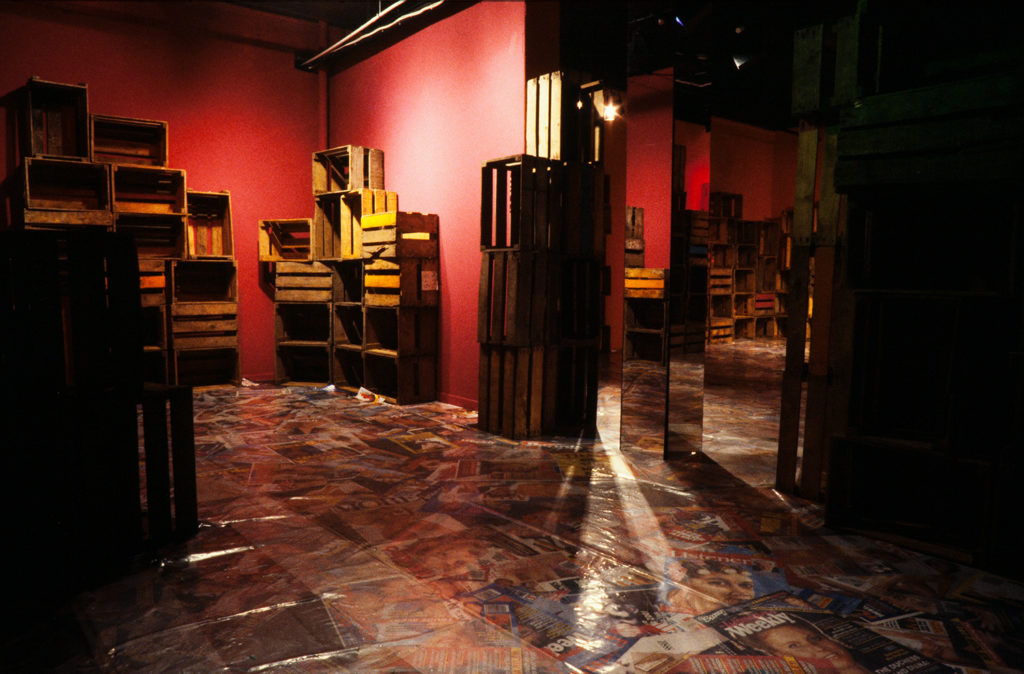'This is an installation of contrast and unexpected couplings—a suggestion that the old and the new, the artificial and the natural, the formal and the informal, the modest and the immodest, the commercially manufactured and the artistically created can and do exist satisfactorily side by side', explains Don Driver.
For Boxes, Driver paints the walls bright yellow, orange, and red, and stacks up wooden fruit boxes against them. A central pillar is clad in mirrors. The floor is plastered with posters of enlarged magazine covers, representing pop stars and pinups, princesses and politicians. Viewers walk over the faces. Allan Purdy's soundtrack component features drums, rattling boxes, and flute. In addition to the installation, a suite of Driver's collages are shown.
Presented to coincide with the International Arts Festival, Boxes is a follow-up to previous Driver installations: Ritual (National Art Gallery, Wellington, 1982), Elephants for Sale (Govett-Brewster Art Gallery, New Plymouth, in 1986), and Bicycles (Sarjeant Gallery, Whanganui, 1986). Driver has lived in New Plymouth since the 1940s. His colourful installations, assemblages, and collages are characterised by sharp wit, and, at times, biting satire.
But is Boxes a misfire? The fact that 'box' is a euphemism for vagina is not lost on Christine O'Brien from Women Against Pornography, who writes to the Gallery expressing anger and disappointment at the show and its presentation as part of the Festival. She writes, 'To enter the installation we are forced to trample on pictures and faces of the bodies of women only to be confronted by walls lined with old boxes and opened into the room, while wall collages depict cut up and grotesque images of women and objects. The total effect of these mutilated images is an overwhelmingly woman-hating and hostile environment for us.'
Boxes coincides with a solo show by New York feminist artist Barbara Kruger at Shed 11, also part of the Festival. The comparison is unfavourable for Driver, who is seen as behind the times. Lita Barrie, writing for National Business Review concludes, 'The timing of the installation, coinciding with Kruger's critique of the manipulation of feminine stereotypes, is incongruous.' In The Dominion, Rob Taylor says Driver's work collapses into 'irrelevance when seen against the vastly superior' Kruger show. In the Evening Post, Ian Wedde is more contrite but admits, 'I have to say Boxes made me uneasy. I had to get out. Maybe that was meant to happen.’
The Ministry of Women's Affairs fields calls from angry women viewers, prompting the secretary to send a letter of concern to City Gallery. Driver defends his installation in the media, explaining, 'I'm making the point that that's how society treats women—as packages, as objects.’ (Driver is no stranger to controversy. His 'gothic' installation Ritual—featuring ten ‘devil’ dolls with goat skulls instead of heads, placed atop oil drums on a dray, like an apocalyptic version of Constable's Hay Wain—caused a furore when shown at New Plymouth's Govett-Brewster Art Gallery, in 1986, and the Dowse Art Museum. Lower Hutt, in 1987.)
The Gallery displays the letters and reviews in the gallery. The show Boxes on.































